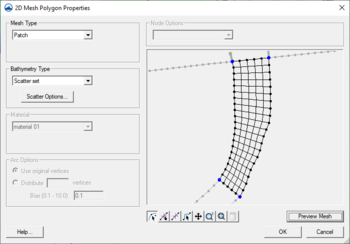Template:SMS at a glance meshing options: Difference between revisions
From XMS Wiki
Jump to navigationJump to search
No edit summary |
No edit summary |
||
| (3 intermediate revisions by the same user not shown) | |||
| Line 1: | Line 1: | ||
[[Image:2D_Mesh_Poly_Properties. | [[Image:2D_Mesh_Poly_Properties.png |thumb|350px|right|''2D Mesh Polygon Properties'' dialog]] | ||
{{{Heading}}} | {{{Heading}}} | ||
* Generating a quality finite element mesh is central to using many SMS models | * Generating a quality finite element mesh is central to using many SMS models | ||
| Line 5: | Line 5: | ||
* [[SMS:Feature Objects Types#Polygons|Polygons]] can use a variety of meshing options to generate triangular or quadrilateral elements | * [[SMS:Feature Objects Types#Polygons|Polygons]] can use a variety of meshing options to generate triangular or quadrilateral elements | ||
* [[SMS:Feature Objects Types#Polygons|Polygons]] can be assigned bathymetry and material information that will be transferred with the mesh | * [[SMS:Feature Objects Types#Polygons|Polygons]] can be assigned bathymetry and material information that will be transferred with the mesh | ||
* | * Constant paving density and [[SMS:Paving#Scalar Paving Density|Scalar paving density]] generates elements with sizes based upon a size dataset allowing for smooth transitions and a large range of element sizes and is particularly useful for coastal and wave models. | ||
** For the constant option, the element target size is specified for each polygon. | |||
* For the spatially varying (scalar paving) option, the target element size is based upon a size dataset on a TIN allowing for smooth transitions and a large range of element sizes. | ** For the spatially varying (scalar paving) option, the target element size is based upon a size dataset on a TIN allowing for smooth transitions and a large range of element sizes. | ||
* Datasets for [[SMS:Paving#Scalar Paving Density|scalar paving density]] can be user defined or generated using the [[SMS:Data Calculator|''Data Calculator'']], the [[SMS:Dataset Toolbox|''Dataset Toolbox'']], or [[SMS:LTEA|LTEA (linear truncation error analysis)]] ([[SMS:ADCIRC|ADCIRC]]) | * Datasets for [[SMS:Paving#Scalar Paving Density|scalar paving density]] can be user defined or generated using the [[SMS:Data Calculator|''Data Calculator'']], the [[SMS:Dataset Toolbox|''Dataset Toolbox'']], or [[SMS:LTEA|LTEA (linear truncation error analysis)]] ([[SMS:ADCIRC|ADCIRC]]) | ||
{{{Link|}}} | {{{Link|}}} | ||
<br style="clear:both;"/><noinclude>[[Category:SMS at a glance]][[Category:SMS 2D Mesh]]</noinclude> | <br style="clear:both;"/><noinclude>[[Category:SMS at a glance|mesh]][[Category:SMS 2D Mesh]]</noinclude> | ||
Latest revision as of 19:32, 19 November 2018
{{{Heading}}}
- Generating a quality finite element mesh is central to using many SMS models
- Conceptual models make generating meshes easier
- Polygons can use a variety of meshing options to generate triangular or quadrilateral elements
- Polygons can be assigned bathymetry and material information that will be transferred with the mesh
- Constant paving density and Scalar paving density generates elements with sizes based upon a size dataset allowing for smooth transitions and a large range of element sizes and is particularly useful for coastal and wave models.
- For the constant option, the element target size is specified for each polygon.
- For the spatially varying (scalar paving) option, the target element size is based upon a size dataset on a TIN allowing for smooth transitions and a large range of element sizes.
- Datasets for scalar paving density can be user defined or generated using the Data Calculator, the Dataset Toolbox, or LTEA (linear truncation error analysis) (ADCIRC)
